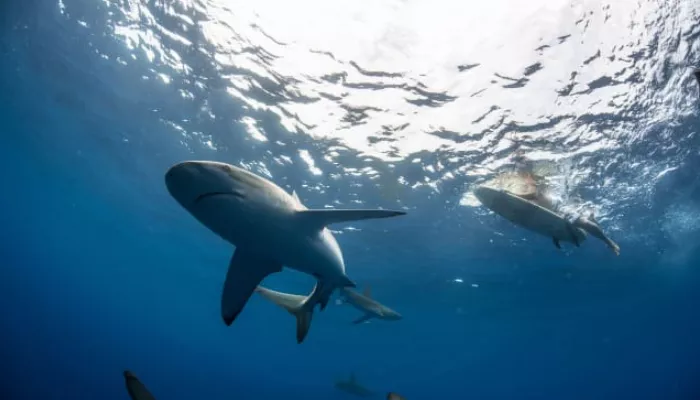Surfers around the globe share the waves with a variety of shark species, some well-known and others more obscure. From the formidable great white to the unique goblin shark, different types of sharks frequent areas close to popular surf breaks. Here’s a rundown of some of the most common shark species you might encounter near the surf.
West Coast
The waters along the U.S. West Coast host a diverse range of shark species. Among them are the docile leopard sharks, which are often seen mating at La Jolla Shores, and juvenile short-finned mako sharks, which frequent the shores from southern Washington to Baja California. Blue sharks are also common throughout the region. However, the species that grabs the most attention is the great white shark, especially during the summer months.
Juvenile great whites are frequently spotted near Southern California surf spots, including Santa Barbara, Huntington Beach, Oceanside, and San Diego. A two-year study by Cal State Long Beach’s Shark Lab revealed that young great whites are often found within 50 yards of the breaking waves, putting surfers and stand-up paddleboarders in close proximity to these predators. Despite the low likelihood of an attack, mistaken identity can sometimes lead to incidents.
East Coast
The East Coast is a hotspot for shark activity, with 335 shark attacks recorded between 2012 and 2021, according to the International Shark Attack File. Popular surf destinations like Myrtle Beach in South Carolina, the Outer Banks in North Carolina, and Cocoa Beach in Florida are frequented by various shark species, including lemon, spinner, sandbar, and hammerhead sharks. Aggressive species such as the blacktip and bull sharks are also common in the area, with the latter posing a risk due to its proximity to murky waters near river mouths.
Florida, with its warm waters and abundant food sources, is home to a wide range of shark species. Studies of sharks caught and released in Southern Florida between 2009 and 2021 found that the most common species were nurse sharks, blacktips, lemons, and bull sharks. Although bull shark attacks are relatively rare, they are a concern for surfers in the area.
Hawaii
Hawaii is home to approximately 40 different species of sharks. The most commonly encountered species include the sandbar shark, whitetip reef shark, scalloped hammerhead, and the notorious tiger shark. Shark encounters in Hawaii are relatively rare, with around three to four incidents per year. However, tiger sharks, which have been responsible for several high-profile attacks, are a particular concern. Notable incidents include the 2003 attack on pro surfer Bethany Hamilton, who lost her arm to a 14-foot tiger shark off Kauai’s Tunnels Beach.
Australia
With a vast coastline stretching over 16,000 miles, Australia is home to a wide variety of sharks. The great white, bronze whaler, Port Jackson, thresher, and blacktip reef sharks are just a few examples. The country has seen a number of shark attacks in recent years, particularly in South Australia and New South Wales. In January 2025, 28-year-old surfer Lance Appleby became the fourth shark attack victim in just 18 months.
Australia has the highest number of shark-related deaths globally, with 22% of all shark attacks on surfers occurring in Australian waters, according to a 2023 study.
South Africa
South Africa’s coastline is home to a remarkable 191 species of sharks. Notably, False Bay, where the renowned big-wave spot Dungeons is located, is home to 27 shark species, including the great white, bronze whaler, guitar shark, soupfin shark, and hound shark. The region gained international attention in 2015 when world champion surfer Mick Fanning was bumped by a great white during the live broadcast of his heat at the J-Bay Open.
While great white sharks tend to dominate the media spotlight, South Africa is home to a rich variety of shark species, making it a unique location for surfers encountering these predators in the water.
Sharks are an essential part of the ocean’s ecosystem, and while encounters with these predators can be alarming, they are still rare. By understanding the species that frequent surf spots worldwide, surfers can enjoy their time in the water while staying informed about the potential risks.
Related topics
- Ridley Launches the Noah Fast: A New Era for Aero Bikes
- Wout van Aert Trades Two Wheels for a Surf-Bike
- Hessmann to Join Movistar After Doping Suspension Ends

